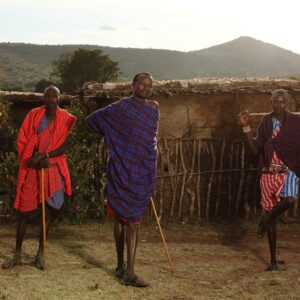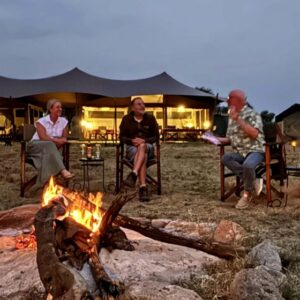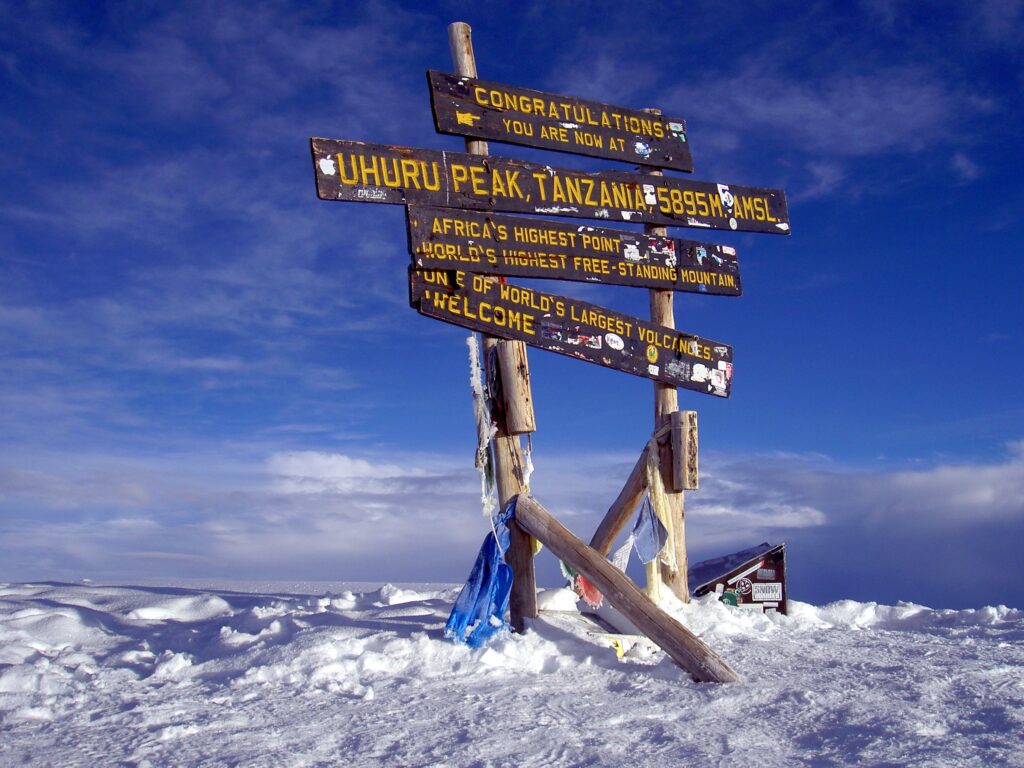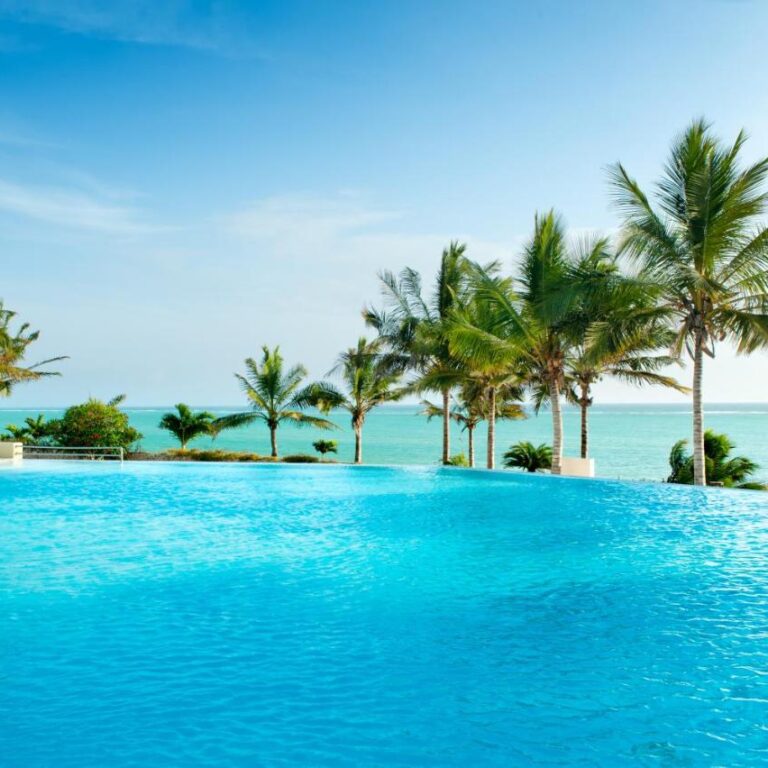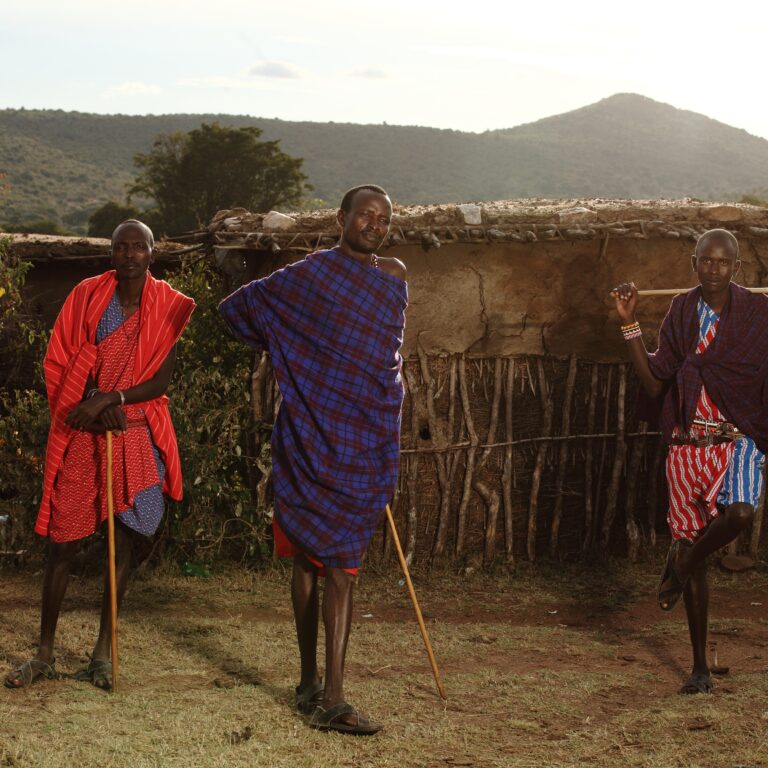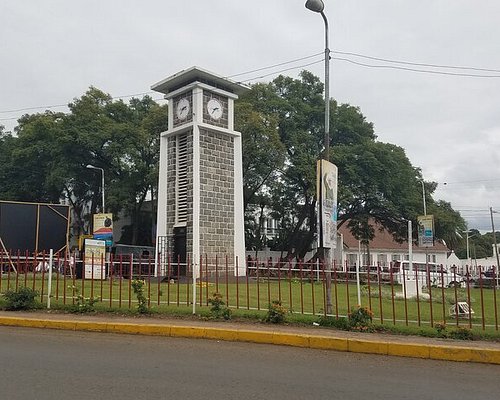At the top of Mount Kilimanjaro is the Uhuru Peak, which is the highest point on its Kibo crater rim. This summit is a barren landscape of rock and ash, but offers breathtaking views. Within the Kibo crater, you can find the Reusch Ash Pit, a smaller, active crater emitting sulfurous fumes. Large, impressive glaciers still exist at the summit, although they have been melting over time. Towering over the savannahs of Tanzania, Mount Kilimanjaro beckons adventurous spirits with the promise of breathtaking views and unparalleled achievement. But what exactly greets those who conquer this epic climb and reach the coveted summit? Kibo, where the summit of Mount Kilimanjaro, namely Uhuru peak, is a dormant volcano, the last eruptive activity happened around 200,000 years ago, forming the crater we see today, with an almost symmetrical cone around the caldera (crater). Book Mount Kilimanjaro Hiking Tours online and save up 15% off early deal!
Kilimanjaro, Africa’s highest peak, beckons adventurers from across the globe. Standing tall at 5,895 meters (19,341 feet), this iconic stratovolcano in Tanzania offers not just a challenging climb but also a truly unique experience at its summit. While the journey to the top is arduous, the rewards are immense, revealing a landscape unlike any other. So, what exactly awaits those who conquer the “Roof of Africa”? Let’s ascend virtually and explore the wonders at the top of Mount Kilimanjaro.
Uhuru Peak: The Crowning Glory
The ultimate goal for every climber is Uhuru Peak, the highest point on Mount Kilimanjaro and the highest free-standing mountain in the world. Reaching Uhuru, meaning “freedom” in Swahili, is a moment of profound triumph. Here, amidst the thin, crisp air, climbers are met with a sense of unparalleled accomplishment and awe. A signpost proudly marks the elevation, providing a quintessential photo opportunity for those who have pushed their limits to stand at this majestic spot. The feeling of being on top of Africa, with the world seemingly spread out below, is an experience that resonates long after the descent.
Kibo Crater: A Glimpse into the Volcano’s Heart
Just a short distance from Uhuru Peak lies the immense Kibo Crater. This vast, almost perfectly circular caldera is a stark reminder that Kilimanjaro is a dormant, yet still powerful, volcano. Descending slightly into the crater offers a dramatic change of scenery, revealing a lunar-like landscape of rock and ash. The sheer scale of the crater is humbling, stretching approximately 2.5 kilometers (1.5 miles) in diameter. It’s a place of quiet grandeur, where the raw geological forces that shaped this mountain are laid bare.
Reusch Ash Pit: The Volcano’s Breathing Hole
Within the Kibo Crater, a more defined feature known as the Reusch Ash Pit commands attention. This is a formidable, almost perfectly circular pit, roughly 130 meters (425 feet) deep and 350 meters (1,150 feet) in diameter. It represents the most recent volcanic activity within the crater, and from its depths, sulfurous fumes occasionally waft, hinting at the lingering geothermal heat below. Standing at the rim of the Reusch Ash Pit provides an intimate look into the volcano’s inner workings, a tangible connection to the fiery origins of this monumental peak.
Glaciers: Remnants of an Icy Past
Despite its proximity to the equator, the summit of Kilimanjaro is home to stunning glaciers. These magnificent ice fields, though receding due to climate change, are a breathtaking sight, especially under the golden hues of sunrise. The Furtwängler Glacier, located near the summit, is particularly notable. These ancient ice formations create a stark and beautiful contrast with the dark volcanic rock, forming surreal ice cliffs and frozen landscapes. They serve as a poignant reminder of the mountain’s ecological fragility and the impact of global warming, making the experience of witnessing them even more profound.
Panoramic Views: A World Above the Clouds
One of the most captivating aspects of being at the top of Kilimanjaro is the unparalleled panoramic views. On a clear day, the curvature of the Earth is visible, and the vast plains of Tanzania stretch out endlessly below. To the east, the sun rises in a spectacular display of color, illuminating the clouds that often blanket the lower altitudes. To the west, the smaller peaks of Mawenzi and Shira, which form part of the Kilimanjaro massif, appear as dramatic sentinels. The sensation of being truly “A World Above the Clouds” is palpable. Below, the world looks like a vast, undulating carpet of white, with only the highest peaks breaking through the ethereal expanse. This elevated perspective offers a sense of profound solitude and connection to the natural world, a truly humbling experience.
Gilman’s Point and Stella Point: Milestones on the Crater Rim
While Uhuru Peak is the ultimate summit, Gilman’s Point (5,685 meters/18,652 feet) and Stella Point (5,756 meters/18,885 feet) are significant milestones along the crater rim, typically reached by climbers ascending the Marangu and Machame routes respectively. Reaching either of these points signifies that the most challenging part of the ascent, the demanding trek through the night to gain significant elevation, has been successfully overcome. These points offer spectacular views in their own right and provide a crucial psychological boost, knowing that Uhuru Peak is now within closer reach. For many, just reaching Gilman’s or Stella Point is an enormous achievement, offering a taste of the summit experience.
What’s at the top of Mount Kilimanjaro?
It’s more than just a physical destination; it’s a confluence of breathtaking views, personal triumph, and a poignant reminder of our connection to the planet. It’s a place where the world stretches out before you, inviting you to dream bigger, climb higher, and cherish the journey as much as the goal.
So, if you’re ever blessed with the opportunity to stand atop Kilimanjaro, take a moment to soak in the panorama, savor the achievement, and let the experience whisper its unique lessons into your soul. It’s a journey that will stay with you long after you step back onto solid ground, leaving an indelible mark on your life and inspiring you to reach for new heights, both literally and figuratively.
New Summit Sign at the Top of Kilimanjaro
The iconic summit sign at the top of Mount Kilimanjaro is more than just a landmark; it’s a symbol of triumph for thousands of climbers who have conquered the “Roof of Africa.” But recently, the sign underwent a transformation, sparking both praise and criticism from trekkers.
The “Old” Sign: Rustic Charm with Wear and Tear
For years, the summit sign stood as a weathered wooden board bearing the inscription “UHURU PEAK, CONGRATULATIONS, TANZANIA 5895M.” Its rustic charm reflected the grueling journey it witnessed, a testament to countless climbers’ determination and resilience. The peeling paint and worn edges added a touch of history and character, making it a cherished photo opportunity for summiters.
The “New” Sign: A Sleek Makeover with Mixed Reactions
In 2012, the Tanzanian National Parks Authority replaced the wooden sign with a shiny green metal one featuring yellow lettering. It boasted the same information but with a more modern and polished look. While some welcomed the change, praising its durability and improved visibility, others lamented the loss of the old sign’s character and sentimental value.
A Sign of Change?
The controversy surrounding the summit sign reflects a broader debate about conservation and modernization on Kilimanjaro. Some argue that preserving the mountain’s natural beauty and cultural heritage takes precedence over modern amenities, while others believe responsible development can enhance the climbing experience without compromising the mountain’s essence.
Ultimately, the value of the sign lies in the personal meaning it holds for each climber. Whether you prefer the rustic charm of the old sign or the sleekness of the new, one thing remains constant: reaching the summit of Kilimanjaro and gazing upon the iconic sign is a deeply moving experience that will forever be etched in your memory.
How was Mount Kilimanjaro formed? Mount Kilimanjaro, Africa’s tallest peak, was formed by volcanic activity associated with the East African Rift. Around 3 million years ago, tectonic plate movements created a rift in the Earth’s crust, allowing magma to rise and erupt, creating three volcanic cones: Shira, Mawenzi, and Kibo. Over time, these cones grew through repeated eruptions, and erosion and glaciers shaped the mountain’s current form. The first to show activity, 2.3 m.y.a., was Shira, which eventually collapsed in on itself, followed by Mawenzi and Kibo. Together, they form the distinctly flat-topped Kilimanjaro. While Shira and Mawenzi went extinct, Kibo continued to rise and is now the summit at 5,895m (19,341 ft).
Why do they climb Kilimanjaro at night? There’s much ground to cover at the summit of Kilimanjaro at night. Another of the key reasons for the night-time start is that there’s so much ground to cover! Regardless of whether the base camp for your summit attempt is Kibo Hut or Barafu Camp, you have to trek for hours to reach the summit.
Do you need oxygen at the top of Mount Kilimanjaro? Heights greater than 26,000 feet are inhospitable for sustained human life. These elevations are sometimes referred to as the ‘Death Zone. ‘ The top of Kilimanjaro is 19,341 feet tall. Therefore, supplementary oxygen is very rarely used on the peak. The high cost of climbing Kilimanjaro is largely attributed to the fees imposed by the Kilimanjaro National Park Authority, a Tanzanian government entity. These fees, which are charged on a daily basis for access and time spent within Kilimanjaro National Park, are substantial.
What is the scariest part of Kilimanjaro? It’s still a challenge, but don’t let anyone scare you by saying that Barranco Wall is a dangerous part of the Mt Kilimanjaro hike. Moreover, just 600 meters from the Barranco camp there is a helicopter evacuation point. Mount Kilimanjaro’s summit, Uhuru Peak, stands at 5,895 meters (19,341 feet)—significantly lower than the 8,000-meter threshold of the death zone. So technically speaking, Kilimanjaro does not have a death zone. However, don’t be lulled into a false sense of security. The temperature at Uhuru Peak, the summit of Kilimanjaro, usually ranges from around -4°C (25°F) at midday to around -27°C (-17°F) in the dead of the night.
How do people sleep in Kilimanjaro? When you trek Mt Kilimanjaro, you sleep in one of two places: in a mountain hut or a tent. Most trekkers sleep in tented camps, as only the Marangu route offers hut accommodation. Fortunately, things are made easier for you as porters carry all of the camping equipment and also set up camp for you. It’s one of the most distinctive features of one of the world’s great mountains: the snowcap atop Africa’s Mount Kilimanjaro. The snow of Kilimanjaro is gradually disappearing, and experts say it may be completely gone by the end of this century.
Tips for visiting the top of Mount Kilimanjaro
To increase your chances of reaching the top of Mount Kilimanjaro, prioritize physical and mental preparation, choose appropriate routes and gear, focus on proper acclimatization, and maintain good hydration and nutrition throughout your climb. Train Physically. Engage in regular cardiovascular exercise and strength training to build stamina and endurance. Consider training with a weighted backpack, and break in your hiking boots thoroughly.
Mental Preparation. Understand that the climb will be challenging both physically and mentally. Maintain a positive attitude and be prepared for potential setbacks. Choose the Right Route. Opt for longer routes like the Lemosho or Northern Circuit, which offer more gradual ascents and better acclimatization opportunities, increasing your success rate. Pack Smart. Invest in high-quality, warm, and waterproof clothing, good hiking boots, and a warm sleeping bag. Pack light, but include essentials like trekking poles, hand/toe warmers, sunscreen, sunglasses, and high-energy snacks.
Hydrate and Eat Well. Begin hydrating several weeks before your trip and continue to drink 4-5 liters of water daily during your climb. Maintain a healthy diet to fuel your body. Consider Altitude Medication. Consult with a healthcare professional about taking Acetazolamide (Diamox) to help prevent or treat altitude sickness. Book with a Reputable Tour Operator. Ensure you have a licensed guide and porters for your climb.
In conclusion
The top of Mount Kilimanjaro is far more than just a single peak. It’s a collection of awe-inspiring natural wonders – from the triumphant summit of Uhuru Peak to the dramatic Kibo Crater and its active Ash Pit, the diminishing but still magnificent glaciers, and the truly breathtaking panoramic views that make you feel like you’re standing on top of the world, quite literally above the clouds. It’s a place where physical endurance meets profound natural beauty, leaving an indelible mark on all who are fortunate enough to experience its wonders.


